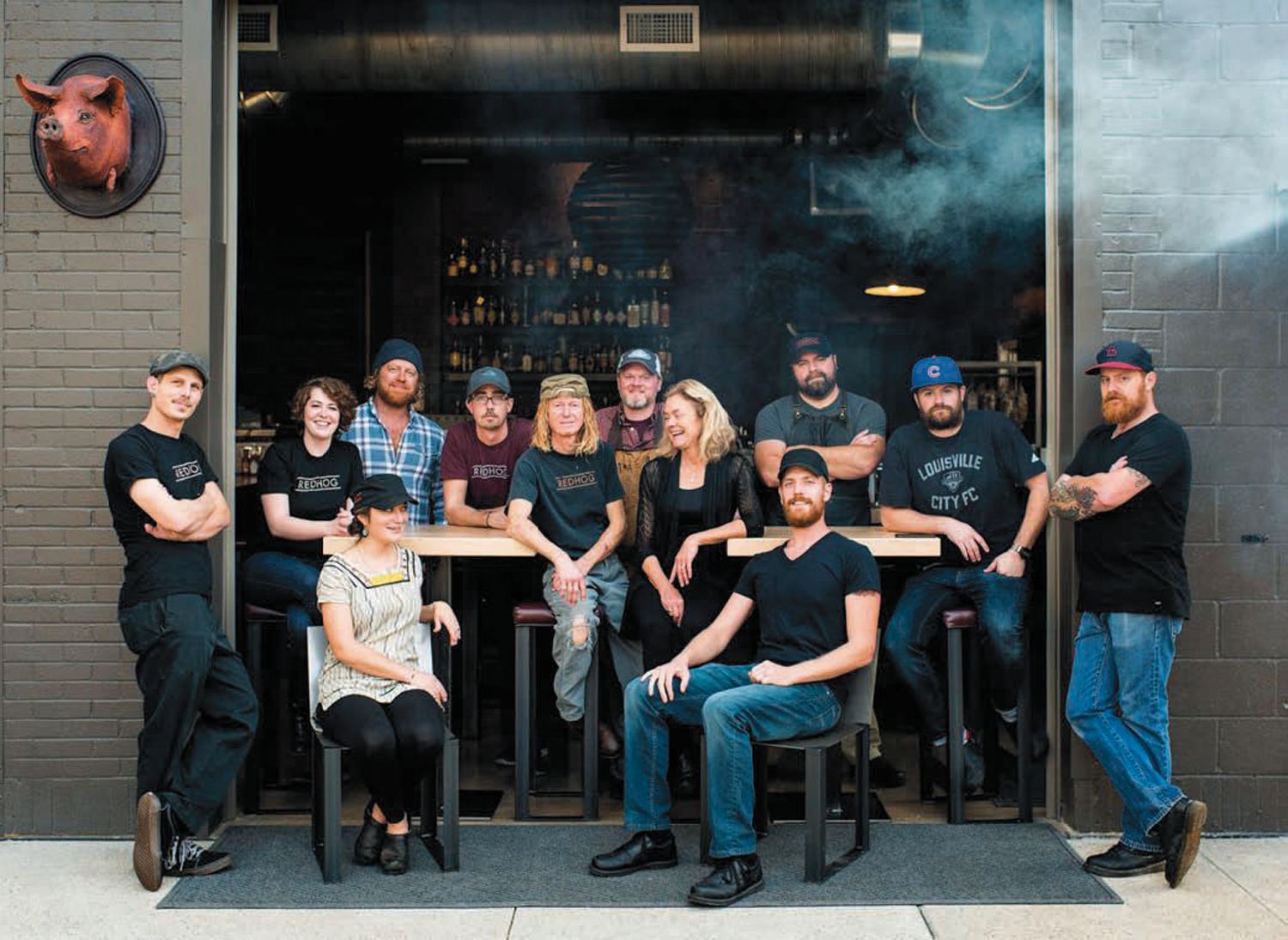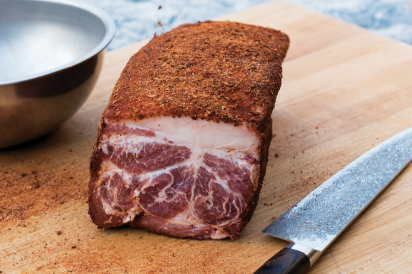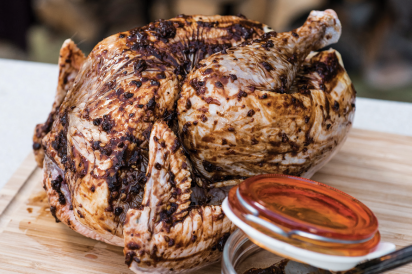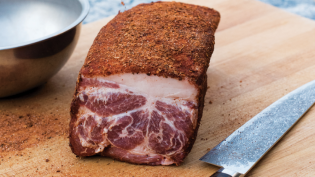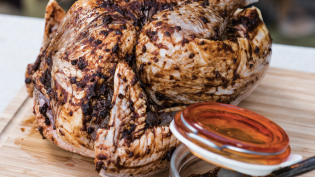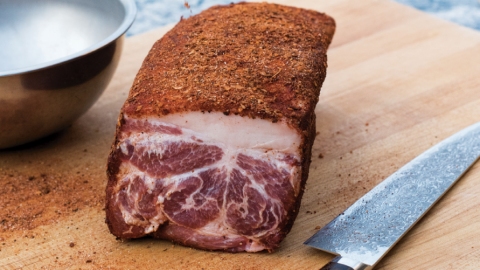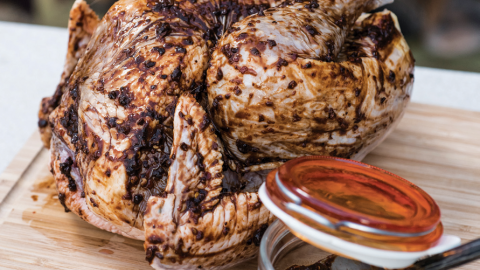Red Hog: This Little Piggy Went to Market
A couple who by all standards have succeeded immensely in creating the best bread in Louisville inevitably confronts “Where do we go from here?” Not content to rest on their laurels, Bob Hancock and Kit Garrett have answered that challenge by creating Red Hog Butcher Shop and Café, located just a few blocks west of their 18-year success at Blue Dog Bakery and Café.
The Kentucky-born couple is a unique combination of taste and talent. Both are well informed and diligent in their research, with the grit and vision to raise their own hogs and guinea hens while reimagining an old-fashioned butcher shop and café featuring artisan cured meats.
Kit’s the unflappable, calm, steady one. Bob is daring, fiercely stubborn and unflinching in his quest for perfection. His treatise, engineered by instinct, trial and error, is that there are some things in life you simply need to know, and one of the most important is where the food you eat comes from, especially the meat.
The restaurant business came naturally to them, though they admit that neither cares much about eating. Bob enrolled in culinary school in Spokane in the early 1990s when Kit took a job there as historic preservation officer for the city. The couple opened Fugazzi, their first restaurant, in 1993, but within a few years they were longing to return home to Kentucky.
Red Hog, at the corner of Frankfort and Franck, is no ordinary butcher shop and restaurant. A repurposed old gas station and garage, the place didn’t open until it was good and ready, buffed and polished to the couple’s expectations. The back of the house boasts a large, walk-in Italian-made curing room with hanging meats. The cinder-block walls of the café are the color of Red Wattle pigs and the tables are made of butcher blocks.
The retail shop features pork the couple raise in Oldham County, as well as poultry, beef, lamb, bison and additional pork sourced from local farmers committed to raising their animals to the highest of standards. Precisely trimmed quality cuts of the meat are sold by weight. Almost nothing goes to waste: pigs ears to tail, snout to rump, bones to broth.
There’s masterfully prepared Red Hog andouille, country pâté, Polish sausage, Braunschweiger, rotisserie chicken, soppressata, mortadella, smoked jowl, pancetta and, of course, bacon. Shelves are also lined with pickles, cheeses, butter and other assorted locally produced and Red Hog signature items, including, of course, fresh bread from Blue Dog. A special sandwich of the day is offered around 11:30am and sells out quickly.
On the eat-in food and drink side, open only in the evening, the chalkboard menu changes daily. Small-plate sandwiches, pizzas, cold plates, wine, craft beers and signature cocktails are among the regular options but on any given day, there are tacos, tartare and other delicious offerings.
Staff knowledge runs deep in both venues as butchers and servers are crosstrained. Kit says, “Duncan Paynter did much of the comparable study of meat markets in other regions and helped us design the ultimate meat production facility. Jay Denham, who has been pursuing pork for years, worked with Duncan to assemble our amazing team of knowledgeable butchers, who not only know how to cut meat but enjoy telling customers how to cook it for maximum enjoyment; and then there is kitchen manager Zack Leezer and our Guatemalan team who raise the bar on all standards.”
Bob and Kit’s credo is “local, sustainable and humane.” Essential to them, as yeast is to dough, is to raise animals the way they exist in nature, to ensure they are treated as humanely as possible as they graze and forage and as they are transported from the field to the abattoir.
Bob, whose introduction to butchering homegrown meat took place as a child at his grandfather’s tenant farm in Trigg County, urges consumers to learn about the origins of the meat they eat.
“All of our meat comes from local farms committed to sustainable, humane and all-natural farming practices,” he says. “The bottom line is to produce ethically raised meat. It is important to know that the animals have had contented, well-fed and properly cared-for lives. Red Hog receives animals fresh from carefully monitored local slaughterhouses that serve small producers. Whole or quartered animals come in the back door, and are carved into pieces on nearby tables and held, cured, or dry-aged to USDA specifications.”
Kit acknowledges the higher-quality cuts of meat at Red Hog are pricier, but suggests it may not be such a bad thing to eat a little less, but better, meat where one can savor the difference in taste of naturally raised animals.
Mark Williams, local chef and southern regional governor of Slow Food USA as well as a director of the National Livestock Conservancy, says “Both Blue Dog and Red Hog are real gifts to our community. Bob and Kit are two of Louisville’s unarguably great locavores.
“Knowledgeable consumers are rightfully suspicious of mass-produced meat. A strong local food economy is an important step in taking back our food supply from factory farms. Buying meat that has been raised by local farmers is one of the best choices we can make. It just makes good sense, when we do eat meat, to choose the best.”
Seemingly indefatigable and totally committed, Bob and Kit share a fierce determination to offer consumers that very best, be it bread or bacon.
RECIPES


